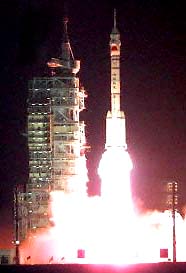| . |  |
. |
|
by Elisabeth Zingg  Beijing (AFP) November 21, 1999 - Forty years after the Soviet Union and the United States, China made its debut in the costly race to conquer space Sunday in what is largely seen as a prestige project.
Beijing (AFP) November 21, 1999 - Forty years after the Soviet Union and the United States, China made its debut in the costly race to conquer space Sunday in what is largely seen as a prestige project.Commenting on the 14 orbits and safe return to earth of an unmanned Chinese space capsule, one Western expert said: "It's a great technical achievement, of course, but this is above all a prestige operation." The state news agency Xinhua reported the space craft "Shenzhou" touched down at 3:41 a.m. Sunday local time (1941 GMT Saturday) after 21 hour in space. A Chinese 'Long March' rocket takes off from the Jiuquan Satellite Launch Center in northwest China's Gansu Province 20 November 1999, carrying the country's first experimental spacecraft. The space craft, named 'Shenzhou' by President Jiang Zemin, is part of China's manned space flight program and has completed a short mission in space touching down in Inner Mongolia. Xinhua/AFP Photo According to Chinese space officials, China will launch its first manned space flight early next century. The semi-official China News Service said "several" unmanned flights would precede this. Xinhua lost little time in trumpeting the success of the flight. "It will strengthen the country's comprehensive national strength, promote the development of science and technology, enhance national prestige and boost the nation's sense of pride and cohesiveness," said the official mouthpiece, quoting an unnamed space programme manager. It added space flight had been a "dream" cherished by the Chinese for 500 years and credited President Jiang Zemin with its realization. The launch closely followed massive parades and days of national celebration as China marked 50 years of communist rule on October 1. In manufacturing the technology to put a manned craft in orbit and allow its safe recovery, the Chinese space industry "has taken a decisive step that should enable it to send a man into space in the next few years," said one Western industry source. The former Soviet Union sent the first manned Vostok spaceship into space in April 1961, piloted by Yuri Gagarin, followed by the United States in February 1962. But the high cost of space exploration has put a severe brake on the American programme, while the break up of the Soviet Union signalled the death of the Mir space station, whose upkeep was beyond Russia's means. In August Mir was abandoned to break up on re-entry into the earth's atmosphere. Cost also sounded the death knell for any European dreams of a manned space programme. European astronauts join Russians and American missions and the Ariane rocket programme has confined itself to unmanned satellite launches. China has given no figures on the financing of its space programme. The official press has merely said it began in 1992. According to Western space industry sources, China once tried to buy Mir itself but also gave up the idea on cost grounds. Besides the prestige, the launch of a manned space mission would confirm the progress made by the Chinese space industry and its "Long March" rockets, which have already placed 25 foreign satellites in orbit and are proving a serious rival to Ariane. To launch the capsule from the new Jiuquan Satellite Launch Center in northwest China's Gansu province, China used the new generation "Long March 2-F" rocket, an improved version of the 2-E which was capable of sending up to 10 tonnes into low orbit. According to the Western expert, the 2-F must be "more precise, more viable and more powerful, capable of carrying 10 to 15 tonnes." The most powerful rocket China had produced until now was the LM 3-B, used to launch geostationary satellites of up to five tonnes and able to put an object of 10 tonnes in a low orbit. It was this rocket that was used to deploy SinoSat-1, a satellite made by the French group Aerospatiale in July 1998. After the LM 3-B exploded during its inaugural flight in 1996, China undertook 17 launches of different Long March rockets, all of which were successful. According to Chinese space officials, Beijing is now in the process of making two new rockets, the LM 1-D and the LM 3-C.
Copyright 1999 AFP. All rights reserved. The material on this page is provided by AFP and may not be published, broadcast, rewritten or redistributed.
A POWERFUL DRAGON
Asian MilSpace Issues At SpaceDaily
|
| |||||||||
| The content herein, unless otherwise known to be public domain, are Copyright 1995-2016 - Space Media Network. All websites are published in Australia and are solely subject to Australian law and governed by Fair Use principals for news reporting and research purposes. AFP, UPI and IANS news wire stories are copyright Agence France-Presse, United Press International and Indo-Asia News Service. ESA news reports are copyright European Space Agency. All NASA sourced material is public domain. Additional copyrights may apply in whole or part to other bona fide parties. Advertising does not imply endorsement, agreement or approval of any opinions, statements or information provided by Space Media Network on any Web page published or hosted by Space Media Network. Privacy Statement All images and articles appearing on Space Media Network have been edited or digitally altered in some way. Any requests to remove copyright material will be acted upon in a timely and appropriate manner. Any attempt to extort money from Space Media Network will be ignored and reported to Australian Law Enforcement Agencies as a potential case of financial fraud involving the use of a telephonic carriage device or postal service. |